Identification and Configuration Optimization of Key Campus Landscape Features Using Augmentation-Based Machine Learning and Configuration Analysis
Abstract
1. Introduction
2. Literature Review and Theory
2.1. Literature Review
2.1.1. Ecological and Environmental Functions of Campus Landscapes
2.1.2. Campus Landscapes and Psychological Perception
2.1.3. Research Methods and Emerging Trends in Campus Landscape Research
2.2. Theoretical Framework
3. Materials and Methods
3.1. Data Collection and Feature Quantification
- Campus street-view acquisition
- Quantification of environmental perception indicators
3.2. Data Processing Workflow
- Workflow for semantic information extraction from street-view images
- Application of CTGAN to imbalanced data
- Fuzzy-Set Qualitative Comparative Analysis (fsQCA)
4. Empirical Results
4.1. Modeling Results of Augmentation-Based Explainable Machine Learning
4.2. Key Semantic Features Influencing Campus Environmental Perception
4.3. Configuration Analysis for Enhancing Campus Environmental Perception
5. Discussion
6. Conclusions
- (1)
- The sense of security is achieved through the combination of high sky openness and high pedestrian traffic, supported by either low building density or low hardscape density. This pathway remains valid even with a certain level of traffic flow.
- (2)
- The formation of comfort follows two distinct pathways: the first is a combination of high road visibility, high pedestrian traffic, and low building density; the second results from the combined effects of high sky openness, low traffic volume, abundant greenery, and active pedestrian activity.
- (3)
- The formation of comfort follows two distinct pathways, while the creation of a sense of belonging can be achieved in three ways: the combination of high road density and open sky views, the pairing of sky openness with a clear walkway system, or the synergy of high road density, ample greenery, and well-defined walkways.
Author Contributions
Funding
Data Availability Statement
Conflicts of Interest
References
- Demuzere, M.; Orru, K.; Heidrich, O.; Olazabal, E.; Geneletti, D.; Orru, H.; Bhave, A.G.; Mittal, N.; Feliu, E.; Faehnle, M. Mitigating and Adapting to Climate Change: Multifunctional and Multi-Scale Assessment of Green Urban Infrastructure. J. Environ. Manag. 2014, 146, 107–115. [Google Scholar] [CrossRef] [PubMed]
- Kumar, P.; Debele, S.E.; Khalili, S.; Halios, C.H.; Sahani, J.; Aghamohammadi, N.; Andrade, M.d.F.; Athanassiadou, M.; Bhui, K.; Calvillo, N.; et al. Urban Heat Mitigation by Green and Blue Infrastructure: Drivers, Effectiveness, and Future Needs. Innovation 2024, 5, 100588. [Google Scholar] [CrossRef]
- Guo, W.; Wen, H.; Liu, X. Research on the Psychologically Restorative Effects of Campus Common Spaces from the Perspective of Health. Front. Public Health 2023, 11, 1131180. [Google Scholar] [CrossRef] [PubMed]
- Liu, H.; Wang, Y.; He, Q.; Wang, X.; Cui, C.; Gong, Y. Assessing the Restorative Effects of Campus Greenness on Student Depression: A Comparative Study Across Three Distinct University Campus Types in Macau. BMC Public Health 2025, 25, 907. [Google Scholar]
- Qi, F.; Parra, A.O.; Block-Lerner, J.; McManus, J. Psychological Impacts of Urban Environmental Settings: A Micro-Scale Study on a University Campus. Urban Sci. 2024, 8, 73. [Google Scholar] [CrossRef]
- Gulwadi, G.B.; Mishchenko, E.D.; Hallowell, G.; Alves, S.; Kennedy, M. The Restorative Potential of a University Campus: Objective Greenness and Student Perceptions in Turkey and the United States. Landsc. Urban Plan. 2019, 187, 36–46. [Google Scholar] [CrossRef]
- Carrus, G.; Scopelliti, M.; Lafortezza, R.; Colangelo, G.; Ferrini, F.; Salbitano, F.; Agrimi, M.; Portoghesi, L.; Semenzato, P.; Sanesi, G. Go Greener, Feel Better? The Positive Effects of Biodiversity on the Well-Being of Individuals Visiting Urban and Peri-Urban Green Areas. Landsc. Urban Plan. 2015, 134, 221–228. [Google Scholar] [CrossRef]
- Speake, M. Campus Landscape and Social Cohesion: The Role of Open Spaces. Urban Des. Int. 2013, 18, 201–210. [Google Scholar]
- Sun, S. The Role of Campus Green Spaces in Enhancing Social Interaction and Well-Being. J. Urban Green Spaces 2025, 24, 112–125. [Google Scholar]
- Lee, J.; Park, B.; Lee, C. Effects of Green Space on Recovery from Mental Fatigue. Environ. Behav. 2008, 40, 517–540. [Google Scholar]
- Berman, M.G.; Jonides, J.; Kaplan, S. The Cognitive Benefits of Interacting with Nature. Psychol. Sci. 2008, 19, 1207–1212. [Google Scholar] [CrossRef] [PubMed]
- Hartig, T.; Mang, M.; Evans, G.W. Restorative Effects of Natural Environment Experiences. Environ. Psychol. 2003, 23, 3–14. [Google Scholar] [CrossRef]
- Kaplan, R. The Restorative Benefits of Nature: Toward an Integrative Framework. J. Environ. Psychol. 1995, 15, 169–182. [Google Scholar] [CrossRef]
- Li, J.; Wang, X.; Zhang, Y. Urban Green Space and Microclimate: Impacts on Thermal Comfort and Urban Heat Island. Landsc. Urban Plan. 2019, 184, 109–118. [Google Scholar]
- Wang, Y.; Huang, S.; Li, X. The Role of Green Infrastructure in Urban Water Management: A Case Study of Rainwater Gardens. Ecol. Eng. 2020, 156, 103–112. [Google Scholar]
- Wang, J.; Zhang, Z.; Li, X. The Ecological Value of Campus Trees in Urban Areas: A Comprehensive Evaluation. Urban For. Urban Green. 2019, 44, 126–137. [Google Scholar]
- Li, L.; Zhang, Y.; Zhao, Q. Optimization of Campus Green Space Layout for Enhancing Ecological Services and Space Utilization. Sustainability 2021, 13, 5141. [Google Scholar]
- McFarland, A.L.; Waliczek, T.M.; Zajicek, J.M. The relationship between student use of campus green spaces and perceptions of quality of life. HortTechnology 2008, 18, 232–238. [Google Scholar] [CrossRef]
- Malekinezhad, F.; Courtney, P.; bin Lamit, H.; Vigani, M. Investigating the mental health impacts of university campus green space through perceived sensory dimensions and the mediation effects of perceived restorativeness on restoration experience. Front. Public Health 2020, 8, 578241. [Google Scholar] [CrossRef]
- Hipp, J.A.; Gulwadi, G.B.; Alves, S.; Sequeira, S. The relationship between perceived greenness and perceived restorativeness of university campuses and student-reported quality of life. Environ. Behav. 2016, 48, 1292–1308. [Google Scholar] [CrossRef]
- Gao, W.; Tang, B.M.; Liu, B. Effects of Landscape Characteristic Perception of Campus on College Students’ Mental Restoration. Behav. Sci. 2025, 15, 470. [Google Scholar] [CrossRef]
- Felsten, G. Where to take a study break on the college campus: An attention restoration theory perspective. J. Environ. Psychol. 2009, 29, 160–167. [Google Scholar] [CrossRef]
- Zhang, J.; Jin, J.; Liang, Y. The Impact of Green Space on University Students’ Mental Health: The Mediating Roles of Solitude Competence and Perceptual Restoration. Sustainability 2024, 16, 707. [Google Scholar] [CrossRef]
- Foellmer, J.; Kistemann, T.; Anthonj, C. Academic greenspace and well-being-Can campus landscape be therapeutic? Evidence from a German university. Wellbeing Space Soc. 2021, 2, 100003. [Google Scholar] [CrossRef]
- Zhang, P.; He, Q.; Chen, Z.; Li, X.; Ma, J. An empirical study on the promotion of students’ physiological and psychological recovery in green space on campuses in the postepidemic era. Int. J. Environ. Res. Public Health 2022, 20, 151. [Google Scholar] [CrossRef]
- Xu, Y.; Wang, T.; Wang, J.; Tian, H.; Zhang, R.; Chen, Y.; Chen, H. Campus landscape types and pro-social behavioral mediators in the psychological recovery of college students. Front. Psychol. 2024, 15, 1341990. [Google Scholar] [CrossRef]
- Diao, W.; Li, S.; Zhao, B.; Zhang, F. Estimation of Mediators in the Associations between Campus Green Spaces and Students’ Anxiety: A Case Study in Nanjing. Front. Psychol. 2024, 15, 1396548. [Google Scholar] [CrossRef] [PubMed]
- Li, L.; Zhang, Y.; Zhao, Q. Campus open spaces and students’ psychological well-being: A meta-analysis. Buildings 2025, 15, 2835. [Google Scholar] [CrossRef]
- Chen, W.Y.; Wang, D.; Zhang, W. Social functional mapping of urban green space using remote sensing and GIS. J. Photogramm. Remote Sens. 2019, 149, 436–452. [Google Scholar]
- Ma, Y.; Zheng, X.; Liu, M.; Liu, D.; Ai, G.; Chen, X. Spatio-temporal evolution characteristics analysis and optimization prediction of urban green infrastructure: A case study of Beijing, China. Sci. Rep. 2022, 12, 10702. [Google Scholar] [CrossRef]
- Zhuang, X.; Tang, Z.; Lin, S.; Ding, Z. Prediction and Optimization of the Restoration Quality of University Outdoor Spaces: A Data-Driven Study Using Image Semantic Segmentation and Explainable Machine Learning. Buildings 2025, 15, 2936. [Google Scholar] [CrossRef]
- Chai, X.; Liu, Y.; Niu, J.; Miao, Y. Landscape Complex Planning in the Big Data Era. Int. J. Agric. Environ. Inf. Syst. 2025, 16, 1–19. [Google Scholar] [CrossRef]
- Weaver, B.J. Mission and Place: Strengthening Learning and Community through Campus Design. Rev. High. Educ. 2006, 29, 545–546. [Google Scholar] [CrossRef]
- Dosen, A.S.; Ostwald, M.J. Evidence for prospect-refuge theory: A meta-analysis of the findings of environmental preference research. City Territ. Archit. 2016, 3, 4. [Google Scholar] [CrossRef]
- Peng, Y.-L.; Li, Y.; Cheng, W.-Y.; Wang, K. Evaluation and Optimization of Sense of Security during the Day and Night in Campus Public Spaces Based on Physical Environment and Psychological Perception. Sustainability 2024, 16, 1256. [Google Scholar] [CrossRef]
- Zhu, M.; Teng, R.; Wang, C.; Wang, Y.; He, J.; Yu, F. Key Environmental Factors Affecting Perceptions of Security of Night-Time Walking in Neighbourhood Streets: A Discussion Based on Fear Heat Maps. J. Transp. Health 2023, 32, 101636. [Google Scholar] [CrossRef]
- Nikolopoulou, M.; Steemers, K. Thermal comfort and psychological adaptation as a guide for designing urban spaces. Energy Build. 2003, 35, 95–101. [Google Scholar] [CrossRef]
- Ambarwati, N.; Faida, L.R.W.; Marhaento, H. The Effects of Green Open Spaces on Microclimate and Thermal Comfort in Three Integrated Campus in Yogyakarta, Indonesia. Geoplan. J. Geomat. Plan. 2023, 10, 37–44. [Google Scholar] [CrossRef]
- Zhang, Q.; Li, Y.; Lin, C. A Study on Outdoor Thermal Comfort of College Students in the Outdoor Corridors of Teaching Buildings in Hot and Humid Regions. Buildings 2024, 14, 2756. [Google Scholar] [CrossRef]
- Elshabshiri, A.; Aly, M.; Alharbat, R.; Abdalla, M.J.; Alsyouf, L.; Ghanim, A.; Yahia, M.W. Enhancing the microclimate of outdoor campus spaces in hot humid climates: The example of the University of Sharjah. Comput. Urban Sci. 2025, 5, 35. [Google Scholar] [CrossRef]
- Liu, X.; Zhao, J. Chinese Migrant Adolescents’ Perceived Discrimination and Psychological Well-Being: The Moderating Roles of Group Identity and the Type of School. PLoS ONE 2016, 11, e0146559. [Google Scholar] [CrossRef]
- Chang, Y.; Yang, Y.; Cai, X.; Zhou, L.; Li, J.; Liu, S. How Campus Landscapes Influence Mental Well-Being through Place Attachment and Perceived Social Acceptance: Insights from SEM and Explainable Machine Learning. Land 2025, 14, 1712. [Google Scholar] [CrossRef]
- Biljecki, F.; Ito, K. Street view imagery in urban analytics and GIS: A review. Landsc. Urban Plan. 2021, 215, 104217. [Google Scholar] [CrossRef]
- Blöbaum, A.; Hunecke, M. Perceived danger in urban public space: The impacts of physical features and personal factors. Environ. Behav. 2005, 37, 465–486. [Google Scholar] [CrossRef]
- Nasar, J.L.; Fisher, B. “Hot spots” of fear and crime: A multi-method investigation. J. Environ. Psychol. 1993, 13, 187–206. [Google Scholar] [CrossRef]
- Vázquez-Torres, C.E.; Beizaee, A.; Bienvenido-Huertas, D. The Impact of Human Occupancy in Thermal Performance of a Historic Religious Building in Sub-Humid Temperate Climate. Energy Build. 2022, 259, 111912. [Google Scholar] [CrossRef]
- Williams, D.R.; Vaske, J.J. The measurement of place attachment: Validity and generalizability of a psychometric approach. For. Sci. 2003, 49, 830–840. [Google Scholar] [CrossRef]
- Cheng, B.; Misra, I.; Schwing, A.G.; Kirillov, A.; Girdhar, R. Masked-attention mask transformer for universal image segmentation. In Proceedings of the IEEE/CVF Conference on Computer Vision and Pattern Recognition (CVPR), New Orleans, LA, USA, 18–24 June 2022; pp. 1290–1299. [Google Scholar]
- Xu, L.; Skoularidou, M.; Cuesta-Infante, A.; Veeramachaneni, K. Modeling tabular data using conditional gan. In Advances in Neural Information Processing Systems; MIT Press: Cambridge, MA, USA, 2019; Volume 32. [Google Scholar]
- Engelmann, J.; Lessmann, S. Conditional Wasserstein GAN-based oversampling of tabular data for imbalanced learning. Expert Syst. Appl. 2021, 174, 114582. [Google Scholar] [CrossRef]
- Zhao, Z.; Kunar, A.; Birke, R.; Van der Scheer, H.; Chen, L.Y. CTAB-GAN+: Enhancing Tabular Data Synthesis. Front. Big Data 2024, 6, 1296508. [Google Scholar] [CrossRef]
- Lázaro, C.; Angulo, C. Iterative application of UMAP-based algorithms for fully synthetic healthcare tabular data generation. Algorithms 2024, 17, 591. [Google Scholar] [CrossRef]
- Li, X.; Zhu, X.; Cao, H.; Huang, W. Research on the Paths of the Modern Agricultural Industrial System Promoting Income Increases and Prosperity for Farmers Based on the fsQCA Method. Sustainability 2025, 17, 2799. [Google Scholar] [CrossRef]
- Wen, H.; Lin, H.; Liu, X.; Guo, W.; He, B.-J. Analysis of the characteristics of university common spaces that affect university students’ psychological restoration. Sci. Rep. 2025, 15, 14146. [Google Scholar] [CrossRef]
- Guo, X.; Zheng, D.; Huang, D.; Gu, J. Research on Influencing Factors of Digital Transformation of Construction Enterprises Based on SEM and fsQCA Methods. Buildings 2025, 15, 3302. [Google Scholar] [CrossRef]
- Zeng, H.; Wang, C.; Chen, J.; Tang, D.; Xu, A. Pathways to tourism industry ecologization: A technology-organization-environment configuration framework. Ecol. Indic. 2023, 156, 111119. [Google Scholar] [CrossRef]
- Wang, X.; Zhang, T.; Luo, S.; Abedin, M.Z. Pathways to improve energy efficiency under carbon emission constraints in iron and steel industry: Using EBM, NCA and QCA approaches. J. Environ. Manag. 2023, 348, 119206. [Google Scholar] [CrossRef]
- Kumar, S.; Sahoo, S.; Lim, W.M.; Kraus, S.; Bamel, U. Fuzzy-set qualitative comparative analysis (fsQCA) in business and management research: A contemporary overview. Technol. Forecast. Soc. Change 2022, 178, 121599. [Google Scholar] [CrossRef]
- Chen, S.; Chen, Z.; Hong, J.; Zhuang, X.; Su, C.; Ding, Z. Exploring the Relationship Between Audio–Visual Perception in Fuzhou Universities and College Students’ Attention Restoration Quality Using Machine Learning. Front. Psychol. 2025, 16, 1572426. [Google Scholar] [CrossRef]
- Kim, Y.; Huh, Y. Analysis of Satisfaction and Characteristics of Using University Campus Gardens for Enhancing the Mental Well-Being of University Students. Int. J. Environ. Res. Public Health 2023, 20, 1977. [Google Scholar] [CrossRef]
- Qin, J.; Zhang, Y.; Li, X.; Wang, Y. Enhancing Student-Centered Walking Environments on University Campuses: A Streetscape Perception Perspective. PLoS ONE 2025, 20, e0321028. [Google Scholar]
- Fu, W. Enhancing University Campus Landscape Design Through Regression Analysis Integrating Ecological and Aesthetic Indicators. Soft Comput. 2023, 27, 11945–11958. [Google Scholar] [CrossRef]

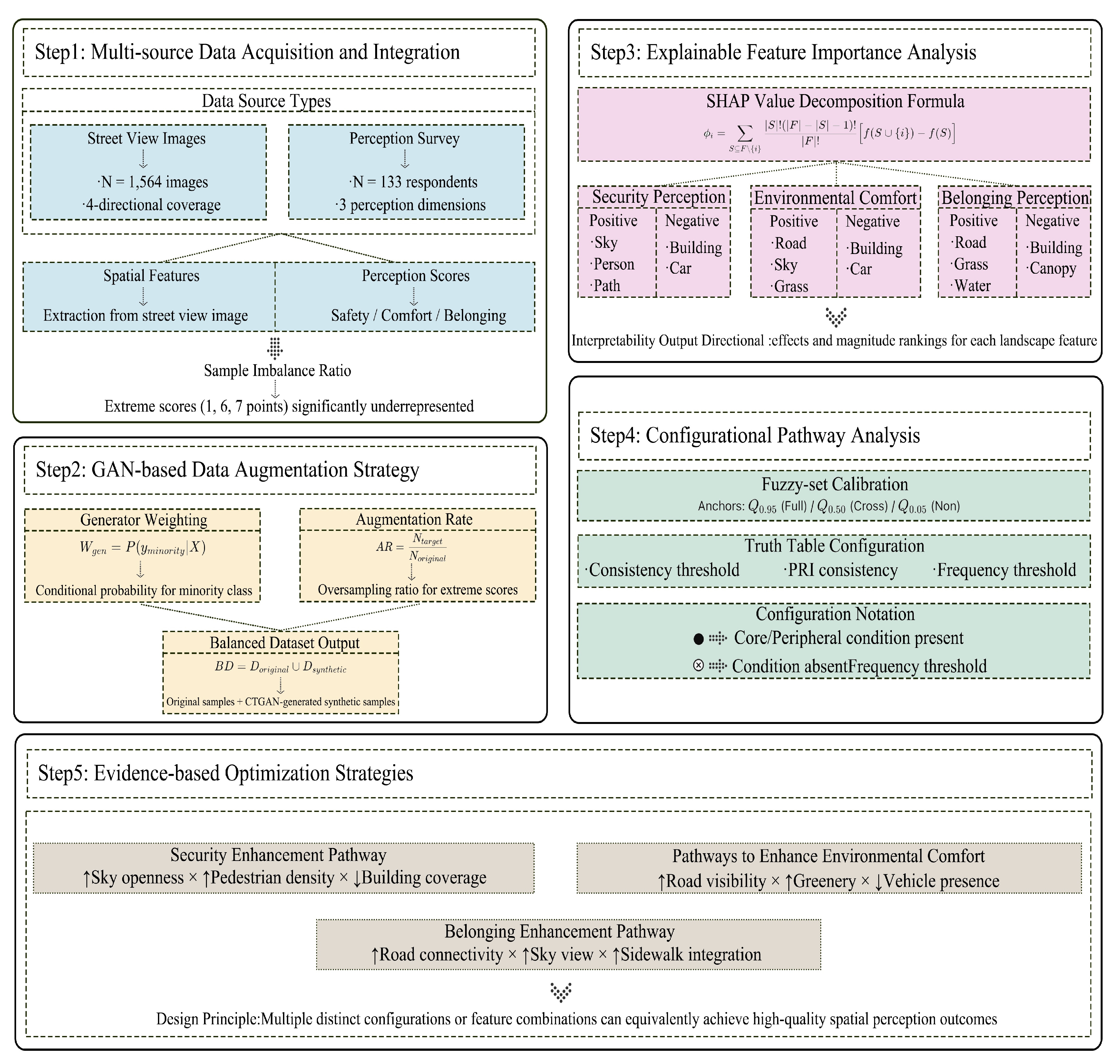
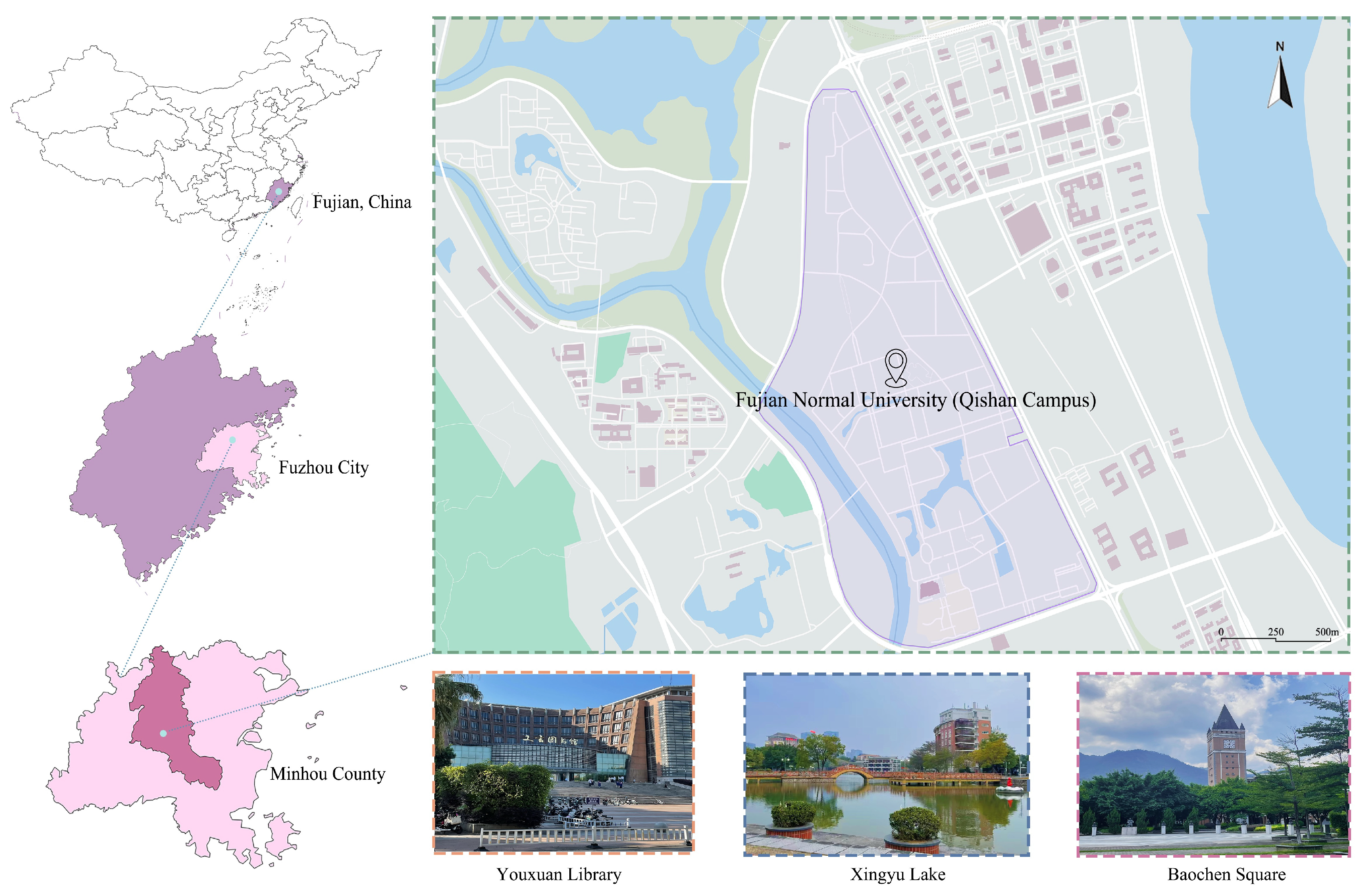
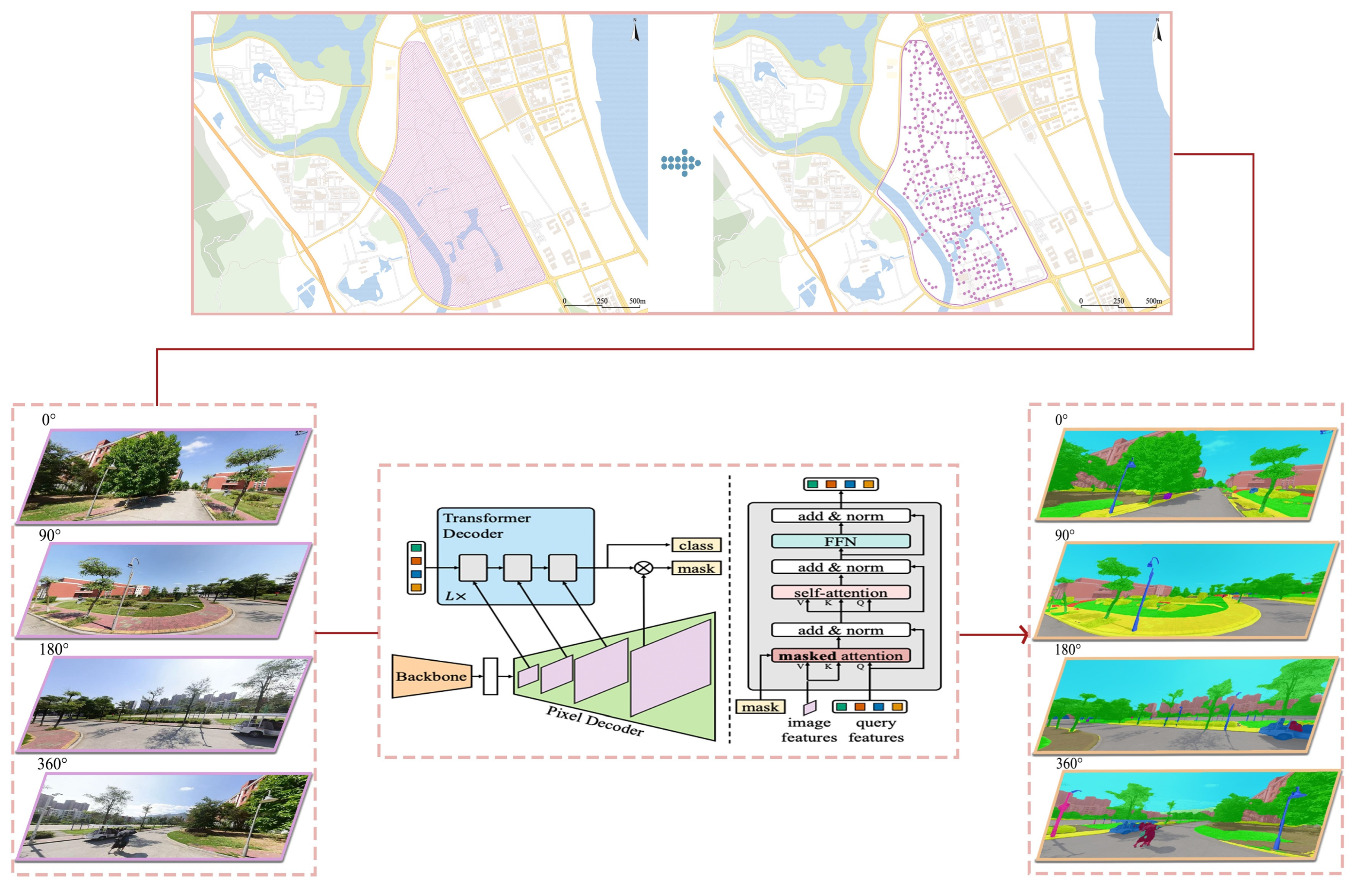
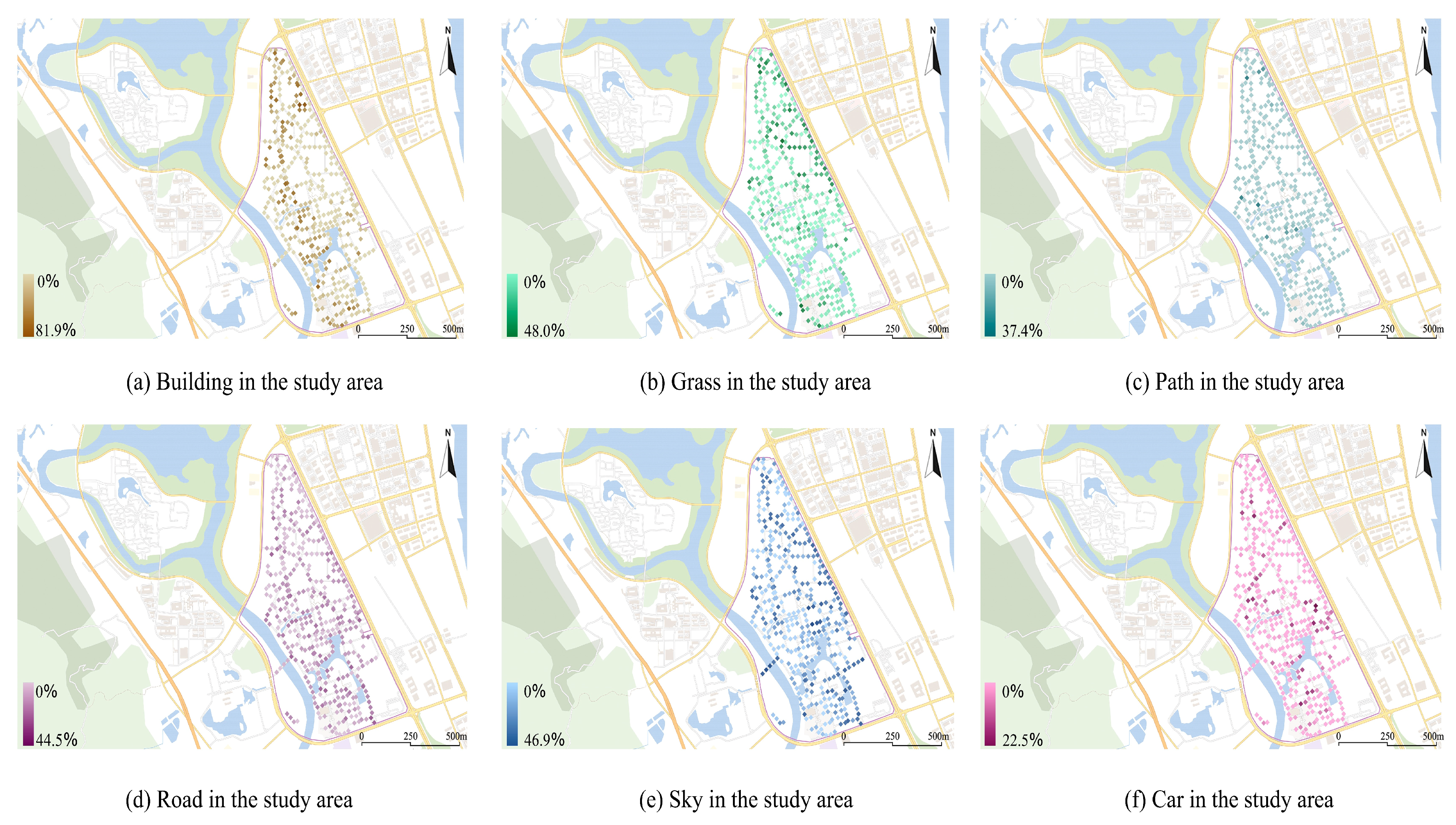
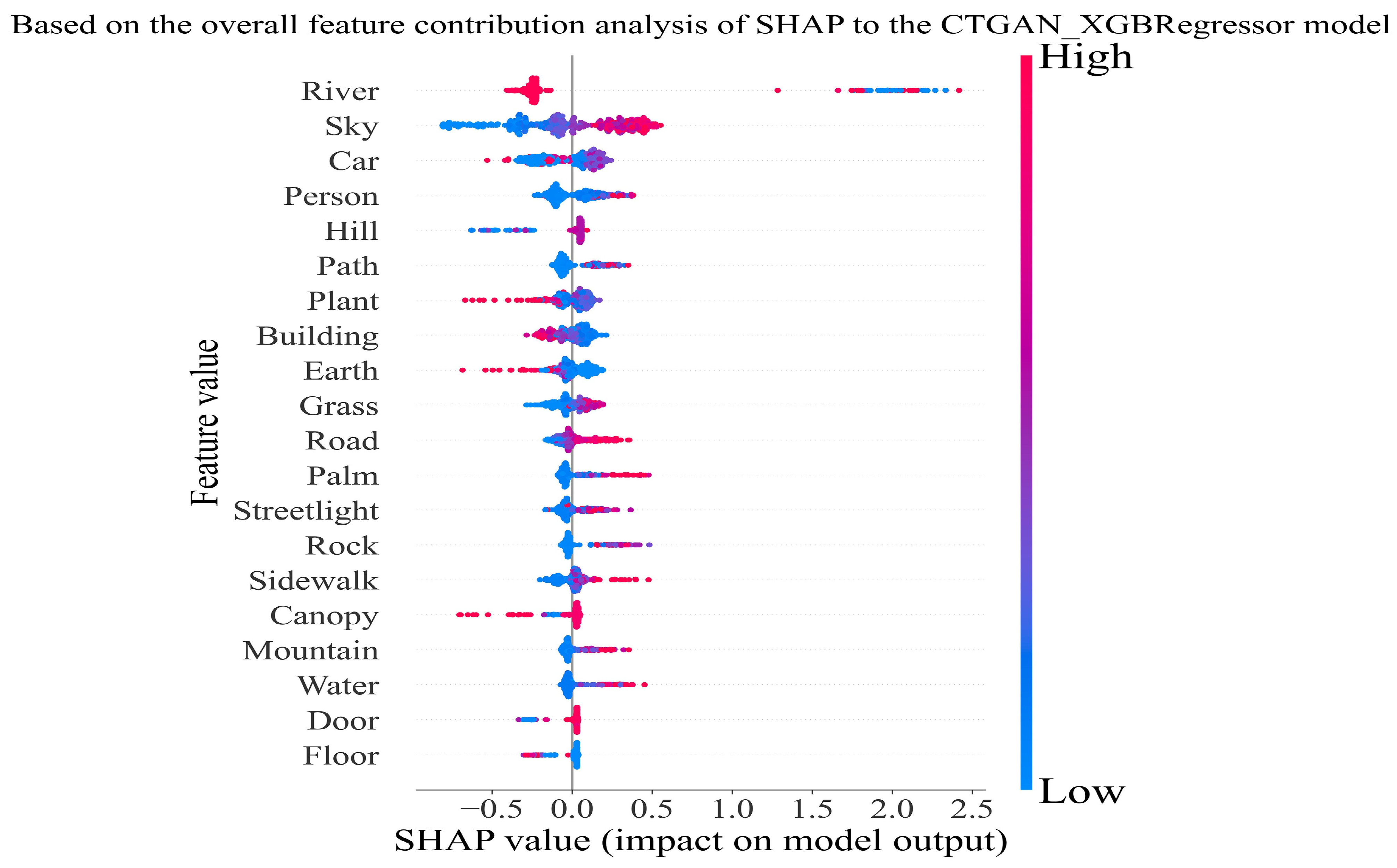
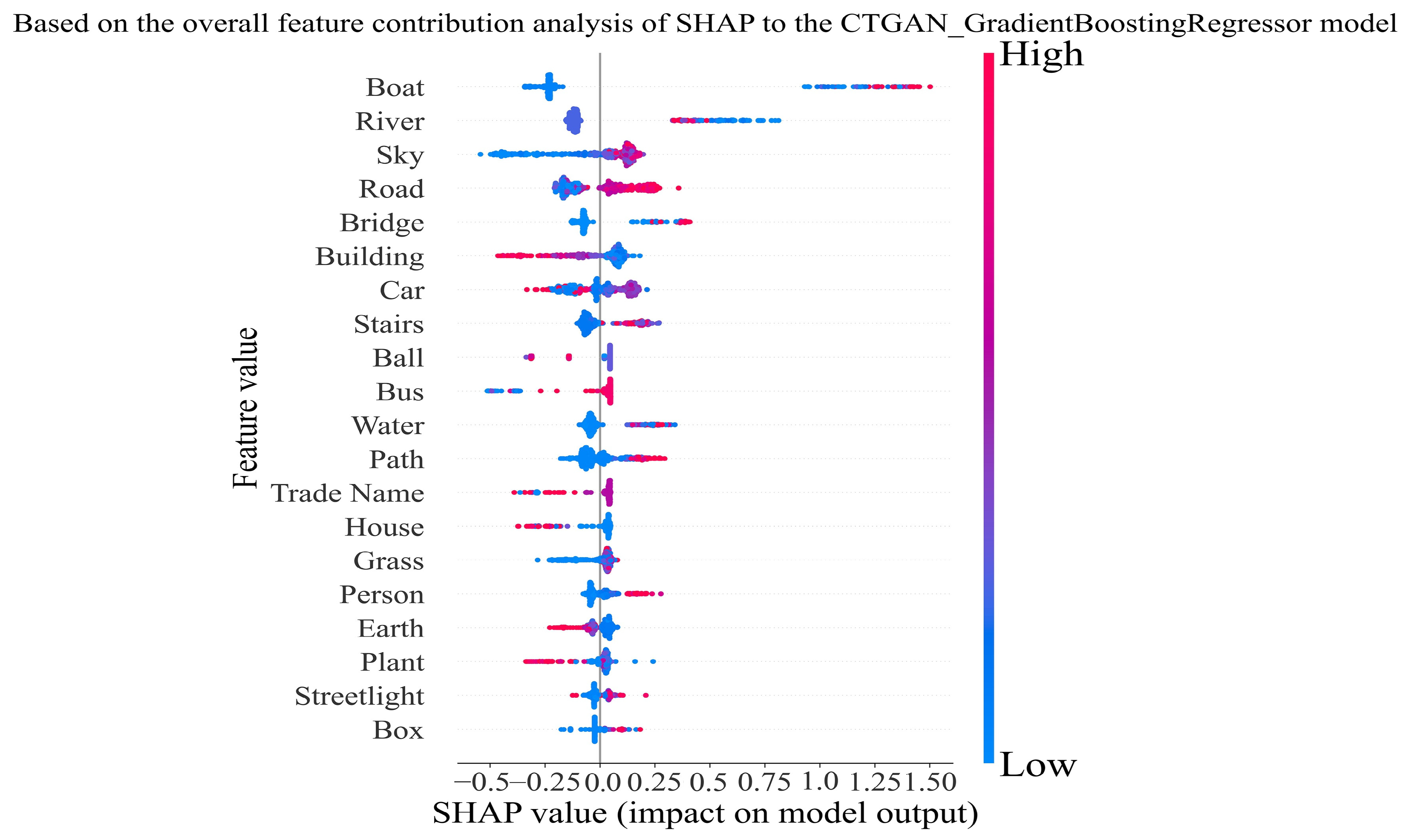
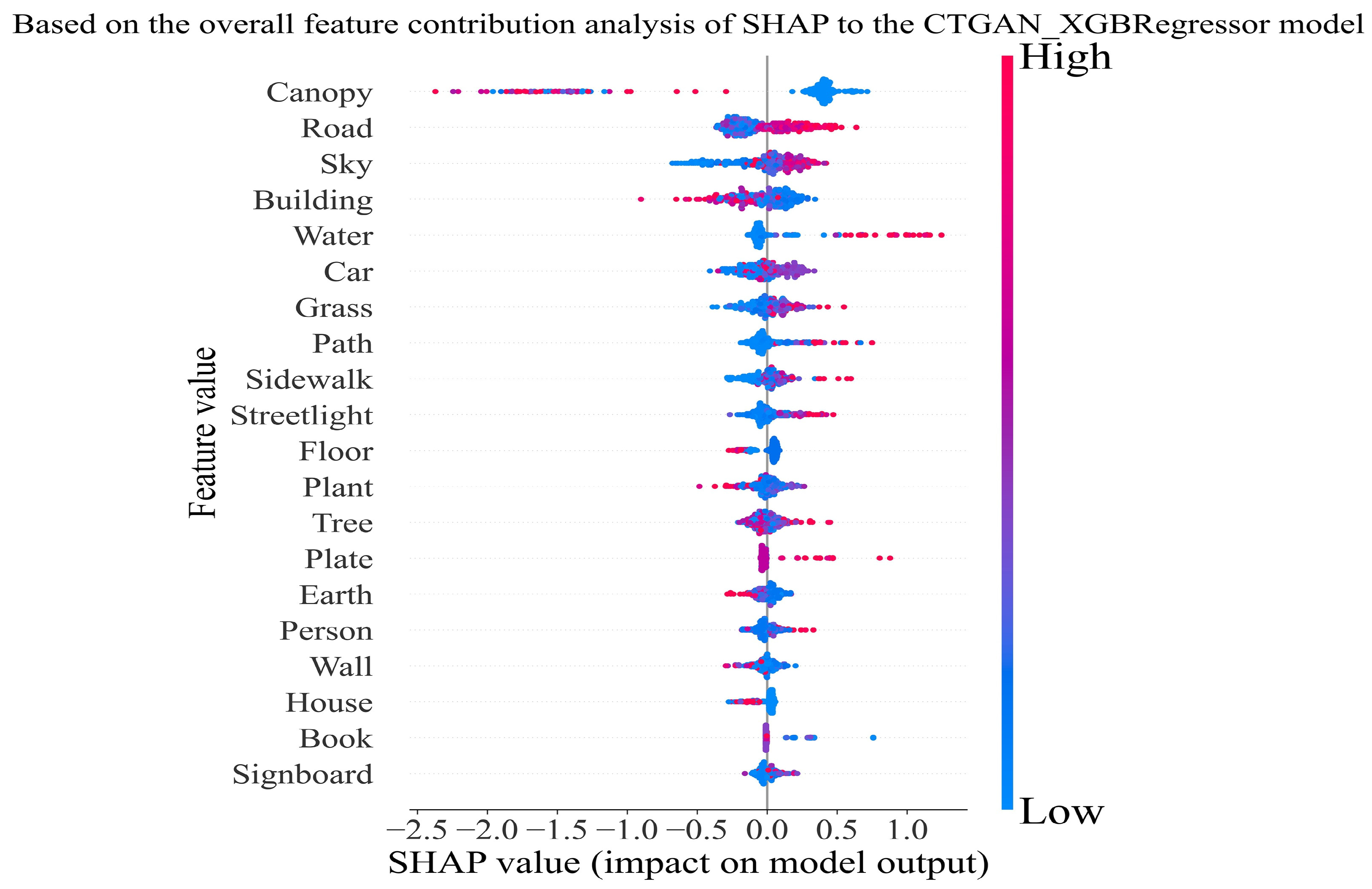
| Indicators Used | Example of Semantic Judgment Items (Based on Street View Images) |
|---|---|
| Sense of security | The street environment, including its lighting and visibility, makes me feel safe and aware of my surroundings. |
| Sense of comfort | The overall environment, including openness, cleanliness, greenery, and air circulation, makes me feel comfortable and at ease. |
| Sense of belonging | The campus environment, with its quiet atmosphere, harmonious design, and strong connection to campus life, enhances my overall sense of belonging. |
| Sense of Security | Sense of Comfort | Sense of Belonging | ||||||||||
|---|---|---|---|---|---|---|---|---|---|---|---|---|
| XGBoost | RF | GBDT | CTGAN-XGBoost | XGBoost | RF | GBDT | CTGAN-XGBoost | XGBoost | RF | GBDT | CTGAN-XGBoost | |
| MSE | 1.33 | 1.69 | 1.51 | 1.21 | 1.34 | 1.21 | 1.19 | 0.88 | 1.56 | 1.59 | 1.58 | 1.00 |
| MAE | 0.93 | 0.98 | 0.95 | 0.83 | 0.95 | 0.89 | 0.89 | 0.72 | 1.02 | 1.03 | 1.02 | 0.76 |
| MAPE | 35.08 | 37.98 | 36.06 | 33.25 | 35.72 | 34.24 | 34.10 | 28.29 | 35.66 | 36.33 | 35.65 | 29.56 |
| Variable Name | Full Membership Point | Calibration Crossover Point | Full Non-Membership Point | |
|---|---|---|---|---|
| Outcome variable | Sense of security | 6 | 4 | 2 |
| Sense of comfort | 6 | 3 | 2 | |
| Sense of belonging | 6 | 4 | 5 | |
| Condition variable | Sky | 0.16 | 14.26 | 35.47 |
| Plant | 0 | 1.10 | 11.88 | |
| Person | 0 | 0.0046 | 1.17 | |
| Car | 0 | 3.34 | 11.01 | |
| Grass | 0 | 6.12 | 28.02 | |
| Sidewalk | 0 | 3.53 | 23.81 | |
| Building | 0.16 | 7.00 | 47.72 | |
| Earth | 0 | 0.13 | 17.10 | |
| Road | 0 | 17.64 | 32.97 |
| Condition Variable | High Level of Sense of Security | |
|---|---|---|
| Overall Consistency | Overall Coverage | |
| Sky | 0.77 | 0.63 |
| Car | 0.56 | 0.61 |
| Person | 0.54 | 0.62 |
| Plant | 0.55 | 0.55 |
| Building | 0.55 | 0.50 |
| Earth | 0.49 | 0.52 |
| Condition Variable | High Level of Sense of Comfort | |
| Overall Consistency | Overall Coverage | |
| Sky | 0.68 | 0.74 |
| Road | 0.68 | 0.74 |
| Building | 0.53 | 0.63 |
| Car | 0.52 | 0.74 |
| Grass | 0.58 | 0.69 |
| Person | 0.49 | 0.75 |
| Condition Variable | High Level of Sense of Belonging | |
| Overall Consistency | Overall Coverage | |
| Road | 0.66 | 0.67 |
| Sky | 0.69 | 0.69 |
| Building | 0.53 | 0.59 |
| Car | 0.49 | 0.64 |
| Grass | 0.59 | 0.65 |
| Sidewalk | 0.57 | 0.66 |
| Condition Variable | Panel A. High Level of Campus Sense of Security | ||
| Configuration A1 | Configuration A2 | ||
| Sky | ● | ● | |
| Car | ⊗ | ||
| Person | ● | ● | |
| Plant | |||
| Building | ● | ||
| Earth | ● | ||
| Consistency | 0.81 | 0.82 | |
| PRI | 0.57 | 0.55 | |
| Coverage | 0.38 | 0.35 | |
| Unique coverage | 0.05 | 0.04 | |
| Overall PRI | 0.53 | ||
| Overall consistency | 0.78 | ||
| Overall coverage | 0.50 | ||
| Condition Variable | Panel B. High Level of Campus Sense of Comfort | ||
| Configuration B1 | Configuration B2 | ||
| Sky | ● | ||
| Road | ● | ||
| Building | |||
| Car | ● | ||
| Grass | ● | ● | |
| Person | ● | ● | |
| Consistency | 0.90 | 0.91 | |
| PRI | 0.72 | 0.72 | |
| Coverage | 0.25 | 0.21 | |
| Unique coverage | 0.01 | 0.01 | |
| Overall PRI | 0.69 | ||
| Overall consistency | 0.85 | ||
| Overall coverage | 0.41 | ||
| Condition Variable | Panel C. High Level of Campus Sense of Belonging | ||
| Configuration C1 | Configuration C2 | Configuration C3 | |
| Road | ● | ● | |
| Sky | ● | ● | |
| Building | |||
| Car | |||
| Grass | ● | ||
| Sidewalk | ● | ● | |
| Consistency | 0.75 | 0.81 | 0.86 |
| PRI | 0.56 | 0.64 | 0.65 |
| Coverage | 0.51 | 0.42 | 0.29 |
| Unique coverage | 0.02 | 0.03 | 0.01 |
| Overall PRI | 0.50 | ||
| Overall consistency | 0.66 | ||
| Overall coverage | 0.83 | ||
| Panel A | Sky | Car | Person | Plant | Building | Earth | F Statistics | |
| Sense of security | 0.0354 *** (0.00) | 0.0005 (0.96) | 0.1215 ** (0.02) | −0.0263 *** (0.00) | −0.0109 *** (0.00) | −0.0344 *** (0.00) | 0.16 | 51.19 |
| Panel B | Sky | Road | Building | Car | Grass | Person | F Statistics | |
| Sense of comfort | 0.02 *** (0.00) | 0.0223 *** (0.00) | −0.0106 *** (0.00) | 0.0041 (0.63) | 0.0072 ** (0.05) | 0.0639 (0.19) | 0.12 | 36.28 |
| Panel C | Road | Sky | Building | Car | Grass | Sidewalk | F Statistics | |
| Sense of belonging | 0.0323 *** (0.00) | −0.0154 *** (0.00) | −0.0091 *** (0.00) | −0.0241 *** (0.01) | 0.0239 *** (0.00) | 0.0374 *** (0.00) | 0.12 | 36.49 |
| Panel A. Application of Explainable Machine Learning Models in Campus Landscape Research | |||
| Author (Year) | Research Object/Dependent Variable | Key Points of Explainable Machine Learning | Limitations |
| Zhuang et al. (2025) [31] | Psychological restoration, emotional uplift, and social interaction | SHAP identifies key features & thresholds; regression checks hidden significant factors | Explainable machine learning identifies key landscape features and thresholds, but its results depend on feature quality, lack causal interpretability, and have limited generalizability across contexts. |
| Chang et al. (2025) [42] | Psychological well-being via psychosocial pathways | SHAP reveals threshold & interaction patterns among predictors | |
| Chen et al. (2025) [59] | Attention restoration quality | SHAP ranks soundscape & visual metrics; finds interaction/threshold effects | |
| Panel B. Application of Multiple Linear Regression Model in Campus Landscape Research | |||
| Author (Year) | Research Object/Dependent Variable | Independent Variables (Landscape/Environmental Features) | Limitations |
| Kim & Huh (2023) [60] | Students’ Mental Health/Psychological Well-Being | Symbolism, visual beauty, frequency of use, and other factors. | Multiple linear regression quantifies relationships between landscape features and perceptions, but it relies on subjective data, struggles with nonlinearities and interactions, and faces issues with multicollinearity and limited explanatory power. |
| Qin et al. (2025) [61] | aesthetics, security, depression, vitality | Buildings, vegetation, grassland, walls, sky openness, etc. | |
| Fu (2023) [62] | Campus landscape design quality/aesthetics-ecological balance | Ecological Diversity Index, Space Utilization Efficiency, Landscape Aesthetics Indicators. | |
Disclaimer/Publisher’s Note: The statements, opinions and data contained in all publications are solely those of the individual author(s) and contributor(s) and not of MDPI and/or the editor(s). MDPI and/or the editor(s) disclaim responsibility for any injury to people or property resulting from any ideas, methods, instructions or products referred to in the content. |
© 2025 by the authors. Licensee MDPI, Basel, Switzerland. This article is an open access article distributed under the terms and conditions of the Creative Commons Attribution (CC BY) license (https://creativecommons.org/licenses/by/4.0/).
Share and Cite
Zhuang, X.; Cai, Y.; Tang, Z.; Ding, Z.; Gan, C. Identification and Configuration Optimization of Key Campus Landscape Features Using Augmentation-Based Machine Learning and Configuration Analysis. Buildings 2025, 15, 3868. https://doi.org/10.3390/buildings15213868
Zhuang X, Cai Y, Tang Z, Ding Z, Gan C. Identification and Configuration Optimization of Key Campus Landscape Features Using Augmentation-Based Machine Learning and Configuration Analysis. Buildings. 2025; 15(21):3868. https://doi.org/10.3390/buildings15213868
Chicago/Turabian StyleZhuang, Xiaowen, Yi Cai, Zhenpeng Tang, Zheng Ding, and Christopher Gan. 2025. "Identification and Configuration Optimization of Key Campus Landscape Features Using Augmentation-Based Machine Learning and Configuration Analysis" Buildings 15, no. 21: 3868. https://doi.org/10.3390/buildings15213868
APA StyleZhuang, X., Cai, Y., Tang, Z., Ding, Z., & Gan, C. (2025). Identification and Configuration Optimization of Key Campus Landscape Features Using Augmentation-Based Machine Learning and Configuration Analysis. Buildings, 15(21), 3868. https://doi.org/10.3390/buildings15213868







